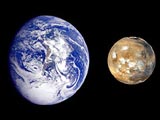 Every 26 months, the Earth overtakes Mars on the inside track as they both orbit the Sun. Every 26 months, the Earth overtakes Mars on the inside track as they both orbit the Sun.
Every 15 to 17 years, this happens when Mars is closest to the Sun. On 27 August this year they will pass at a distance of 55,760,000 km, closer than any time during the last 60,000 years. At its closest, Mars will be 25 seconds of arc in diameter, the size of a tennis ball at a distance of 528 metres. However, on the scale of the tennis ball, this approach is only 18 centimetres closer than in 1924, although 110 metres closer than in 2001.
Throughout July, August and September, Mars will be easy to see with the naked eye. Each night it will rise earlier, until by late August it will be just above the horizon, south of east, soon after sunset. Once risen, it will be the brightest object in the sky, appearing orange red. From the latitude of the UK, it will never rise higher than 22 degrees and you will need an unobstructed view to the south to see it. Mars will appear at its very best from the Southern Hemisphere, where by the middle of the night it will be high in the sky and its brightness and colour will make it very obvious. To see any surface detail requires a good quality telescope with a lens or mirror diameter of about 10 cm, on a stable mount. If you don't have one - and few people do - try to visit a public observatory or your local astronomical society. (Agencies) | 地球和火星都在各自的軌道圍著太陽運轉。每隔26個月,地球就要從內圈兒超過火星一次。 每隔15到17年,地球剛好在火星距離太陽最近的時候超過它。 今年8月27日,它們將再一次擦肩而過。屆時二者相距5576萬千米,這是6萬年來最近的的一次。 在最近的地方,火星的直徑是25弧秒,看上去跟528米以外的網球差不多大。 然而,以網球的比例來看,這次僅比1924年時靠近了18厘米,盡管比2001年近了110米。 在七、八、九三個月中,人們用肉眼就可以看到火星。每晚它升起的時間都會比前一天早一些,到八月底時,火星將在黃昏之后從地平線上升起,東偏南一點。 火星一升起來就將成為天空中最明亮的物體,呈橘紅色。從英國所在的緯度上來觀察,火星與地面的角度不會超過22度,人們需要在朝南的方向找個視野開闊的地方才能看到火星。 南半球是觀察火星的最佳地點。午夜時分,它將高高地懸掛在天空中,它的光芒和色彩將使其分外耀眼。 要仔細觀察火星表面,需要有一部鏡頭直徑約10厘米的優質望遠鏡,架在固定底座上。不過有這種望遠鏡的人很少,如果你沒有的話,那就去公共天文臺或當地的天文協會吧。 second: 秒角度單位,相當于六十分之一度 (中國日報網站譯) |
